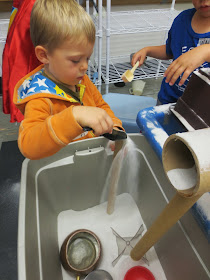Last week I introduced a new apparatus:
Cardboard Tubes Embedded in a Cardboard Tube.
Whenever a new apparatus is introduced or offered as an invitation to play, I usually have some idea how the the children will approach it. For instance, I knew there would be lots of pouring down the smaller tubes.
Since the apparatus is built so the smaller tubes can be taken out, the children were certainly going to pull the tubes out of the larger tube---and then pour sand through the open holes.
(If you have been reading this blog long enough, you will notice this is a new feature for an apparatus. There may be plenty of loose parts provided on the shelf next to the apparatus, but up to this point there have been no loose parts built into the apparatus itself. Is this the start of something?)
Since I turn the apparatus over to the children to make it their own, I am extremely curious about the whole host of other operations that are not foreseen. That curiosity spurs me to step back and observe to see how the children engage in a dialogue with the apparatus, the medium, the provisions and each other. Below are some examples of that dialogue.
Since funnels are provided, you would expect a child to use a funnel to aid in pouring the sand down the tube. Would you expect a child to use three? How does that change the experience from using just one?
Use of the funnel also provided an opportunity for children to work together. Below one child is pouring sand down the tube with a funnel from the top while the other is catching it on the bottom with a scoop. Without the funnel, the child at the bottom would want to move because sand would surely fall on him. It turns out to be a good example of coordination and cooperation.
One child found a different use for a funnel by adding one of the loose pieces of pipe that was provisioned on the shelf next to the table. He found out he could plug the funnel with the pipe so no sand flowed through the funnel.
When he removed the pipe, the sand naturally filtered through the funnel. He added another twist to the pouring, though, by pouring sand directly through the pipe straight into the hole of the funnel. It was more of a challenge to get the sand in the pipe, but any sand that did not go into the pipe was caught by the funnel. Did he realize he just created a catchment for the sand?
One child even figured out how to fill one of the loose tubes with sand. As long as the bottom of the tube was buried in the sand, he could pour sand in one end to fill it up.
But what do you do with it once you have filled up the tube? This boy lifted the tube out of the bin using one hand to hold the sand in from the bottom. After standing up, he let 'er rip.
Why and how does a child come up with this operation? He definitely wants to see the sand shoot out the end of the tube, but the result is so short considering how long it took him to fill it. And he does it again and again.
Since the tubes do come out, they can also be put back into the holes. If the holes were bigger that would be an easy task, but since they are not, it takes effort to get the smaller tubes back in the larger tube.
Now the apparatus turns out to be a real-life, 3-D puzzle. Is there any better kind?
One more interesting operation was created by a child as she tried to get sand out of one end of the big tube. The most intriguing part is at the beginning of the video: the child has figured out by tapping the big tube with her bowl, sand drops down into her bowl. (She cannot put words to what she is doing, but by knocking the tube with her bowl, she is creating vibrations in the tube that cause the sand to drop from the end of the tube.) She does not get the results she wants quick enough so she simply starts scraping the sand into her bowl with her little scoop.
I continually wonder why and how the children fabricate such a myriad of novel operations. Can this "messing about" be considered real science?
P.S. If you are going to the NAEYC national conference in Washington DC in November, I am presenting on sand and water tables. The session is on Saturday morning from 8:00-9:30, so we will see who are the early birds. If you have been to my presentations before, it has changed a bit and been updated. If you cannot make the session or have questions about building in and around the table that will be hard to answer during the formal presentations and would like to chat, please contact me through the blog or directly through email: tpbedard@msn.com I would also be interested to talk to anyone who has actually been inspired to build apparatuses to find out how it went.



























